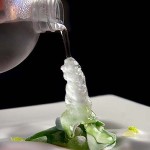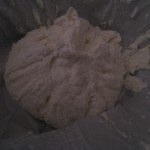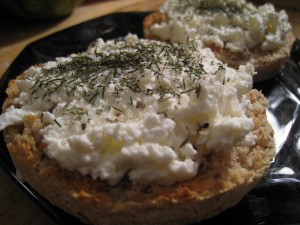One day, while I was procrastinating from doing homework for my online Science and Cooking class and a million other tasks by poking around on Arts & Letters Daily, I came across this article from the London Review of Books. Apparently, I am not the only person who was lured into taking a Harvard science class by the insertion of “cooking” into the title. Just remember, readers, where you heard it first.
 When I did finally stop surfing the web and started doing my online coursework, I noted dismally that I am falling pretty far behind. I have waded through material on phase changes, but I still confuse elasticity and plasticity, and who knows when I’ll finally get around to spherification. I think the main problem is that I get weirdly hypnotized by certain videos and have to stop working to let them sink into my brain. For instance, who would have guessed that very, very pure water doesn’t freeze easily, even in a refrigerator that is kept below the freezing point, because there are no microscopic bits of muck for the ice crystals to glom onto? It’s called supercooling (no, I am not making that word up), and it allows for wacky poured ice sculptures to be created at the table by fancy chefs like Jordi Roca. (Note: the instant formation of it is more magical and less phallic than this still image would have you believe.) Seriously, don’t you feel like you need a few minutes to digest that image before you memorize some formulas? I did.
When I did finally stop surfing the web and started doing my online coursework, I noted dismally that I am falling pretty far behind. I have waded through material on phase changes, but I still confuse elasticity and plasticity, and who knows when I’ll finally get around to spherification. I think the main problem is that I get weirdly hypnotized by certain videos and have to stop working to let them sink into my brain. For instance, who would have guessed that very, very pure water doesn’t freeze easily, even in a refrigerator that is kept below the freezing point, because there are no microscopic bits of muck for the ice crystals to glom onto? It’s called supercooling (no, I am not making that word up), and it allows for wacky poured ice sculptures to be created at the table by fancy chefs like Jordi Roca. (Note: the instant formation of it is more magical and less phallic than this still image would have you believe.) Seriously, don’t you feel like you need a few minutes to digest that image before you memorize some formulas? I did.
 Another problem is that I’m lagging behind on my labs. The use of my disorderly, cluttered kitchen as a laboratory makes me nervous and leaves me with little hope of precision. But when I can rouse myself to action, they usually prove interesting. By far the best lab so far has been making ricotta cheese from a quart of milk and a little white vinegar. I’m actually not sure what I was supposed to learn about phase changes from this, but I made cheese, guys! From scratch. Okay, yes, I know I could buy an inexpensive vat of the stuff from any grocery store, but cradling its warm milky form, I felt a teensy-weensy shadow of what a parent must feel when they hold a newborn, a pride of creation. I ate it until I felt sick.
Another problem is that I’m lagging behind on my labs. The use of my disorderly, cluttered kitchen as a laboratory makes me nervous and leaves me with little hope of precision. But when I can rouse myself to action, they usually prove interesting. By far the best lab so far has been making ricotta cheese from a quart of milk and a little white vinegar. I’m actually not sure what I was supposed to learn about phase changes from this, but I made cheese, guys! From scratch. Okay, yes, I know I could buy an inexpensive vat of the stuff from any grocery store, but cradling its warm milky form, I felt a teensy-weensy shadow of what a parent must feel when they hold a newborn, a pride of creation. I ate it until I felt sick.
So though I have not yet mastered Science and Cooking, I trudge forward, feeling renewed respect for college students everywhere and the immense number of hours they devote to passing their classes, even relatively silly ones that require them to measure compressed tortillas. Truly, if a college student is visiting you over the holidays, you should be kind to him or her. Let her sleep late. Buy him a book about beer. Try not to utter the word “postmodern” in her presence. And while you’re waiting for him to wake up, grab a thermometer and make some ricotta.
EdX and Harvard’s Ricotta Cheese Recipe
When prepared with salt, this recipe makes a delicious homemade ricotta cheese. When prepared without salt, it is instead a traditional Catalan cheese called mató, that is usually eaten with honey. You can choose which of these cheeses you want to make by adapting the recipe below.
Materials:
- 1 stove or hot plate
- 1 pot
- 1 strainer
- 1 whisk
- 1 thermometer
- measuring spoons
- cheese cloth
- 1 large bowl (for water bath)
- 1 medium bowl (for straining)
Ingredients:
- 1 liter whole milk
- 2 Tbsp white vinegar (30 ml)
- ½ tsp salt (2.5 ml) or honey
- Crackers
Procedure:
- Prepare a big bowl with ice+water to put the pot in later.
- Arrange the cheese cloth into four single layers, place it over a strainer, and put the strainer over a bowl as shown in the picture below.
- Heat the milk while stirring (with salt if you chose to make ricotta, without salt if you chose to make mató). When the milk reaches 198˚F/92˚C, remove the pot from the stove or hot plate, quickly mix in vinegar (no more than a few seconds), and then, let sit and do NOT stir. **This step is critical. If you continue mixing the milk+vinegar mixture, you will prevent the coagulation from happening and will end up with no cheese.**
- Place the pot in the bowl of ice+water to cool down.
- When the temperature reaches 97˚F/36˚C, pour the contents of the pot onto the strainer covered with cheesecloth. This allows the whey to pass through, while the curds remain in the strainer. You may occasionally have to stir the curds gently to help the whey drain.
- Fold the edges of the cheesecloth over the curds, and put everything (strainer+bowl) in the fridge to chill for 20 min or longer.
- Eat with crackers. Add honey for the traditional version of Catalan mató.

